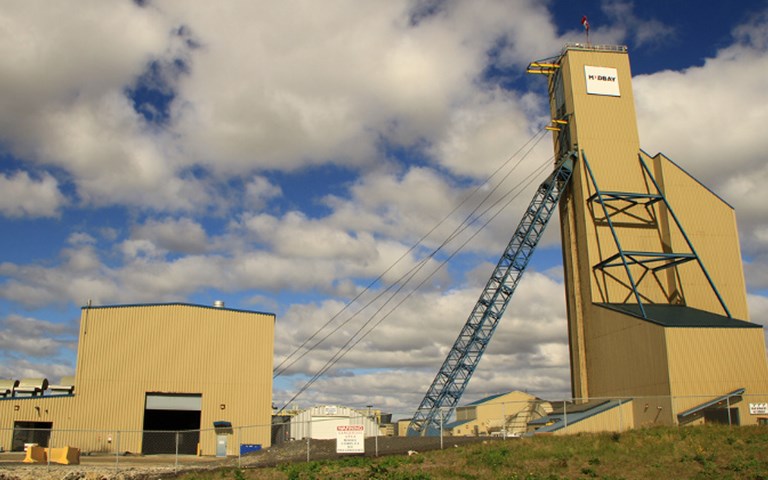Hudbay's 777 mine in Manitoba. The company said it would respond "in due course" for a request for a special shareholder meeting by Waterton Global Resource Management. Courtesy of Hudbay Minerals
Welcome back to your weekly mining news recap. At the end of the week we’ll catch you up on the mining news from CIM Magazine and elsewhere that you may have missed. Now that our website works again we’ve returned to regular news posting with a vengeance, so strap in because this week’s recap is jam-packed with news. In this week’s headlines: Hudbay squares off with an activist shareholder, the Canada Revenue Agency appeals a tax court decision in favour of Cameco, and a whole bunch of Q3 reports.
*****
The B.C. government introduced new legislation on Monday that aims to apply uniform standards and further government oversight to qualified professionals in the province’s resource extraction industries. The Professional Governance Act is based off the findings of a review of B.C.’s professional reliance system by University of Victoria environmental law professor Mark Haddock, which was released this summer. The act will establish an “office of the superintendent of professional governance” that will take several self-governing professional regulators, including the Engineers and Geoscientists of British Columbia, under its umbrella.
Trevali Mining downgraded production at its Caribou zinc-lead-silver mine in New Brunswick on Tuesday due to challenging rock conditions. The company said that work could not continue at its current pace without putting its workers’ safety at risk, and as a result lowered its zinc 2018 production guidance by 17 per cent and lead production guidance by 12 per cent, and revised its operating costs upward.
B2Gold said on Tuesday that the expansion study for its El Limon gold mine in Nicaragua found the potential for both a higher annual processing rate and a mine life increase of 10 years with the inclusion of the inferred mineral resource from the El Limon Central deposit. The study recommends making upgrades to the mine’s existing plant that would increase its processing rate to 600,000 tonnes per year, up from 485,000 currently. Then on Thursday, the company announced it had increased the Mineral Resource estimate at its Fekola mine in Mali and had begun studying the possibility of expanding production there, as well.
Resource investment firm Waterton Global Resource Management has taken issue with the direction of Hudbay Minerals and is calling for a special meeting of the company’s shareholders to rally against Hudbay’s reported plans to acquire Chilean mining company Mantos Copper for $1 billion. Waterton says Hudbay’s board, which has a collective 0.12 per cent ownership of the company, is disconnected from the company’s performance. Hudbay said it will respond to the requisition “in due course.”
Teck’s new water treatment facility has posted significant reductions in selenium and nitrate levels in the Elk River Valley watershed in British Columbia at a greatly reduced cost. The saturated rock fill (SRF) facility has the potential “to augment or replace traditional active water treatment technology at approximately one-sixth the capital cost and half the ongoing operating cost,” Teck spokesman Chris Stannell told us. The SRF facility is part of Teck’s $600-million undertaking in improving the water quality of the Elk River Valley that started in 2013.
Barrick Gold posted an asset impairment of US$405 million for its Lagunas Norte open-pit operation in Peru in its third-quarter results on Wednesday, resulting in a net loss of US$412 million for the quarter. The company reported adjusted net earnings of US$89 million. The impairment is related to the results of an updated feasibility study that recommended only going forward with processing carbonaceous materials and not pursuing the treatment of refractory sulfide ore.
This week has been heavy in third-quarter releases, and the Financial Post has a good recap of how results from Goldcorp, Detour Gold and Newmont Mining went over with investors and analysts. Meanwhile, Agnico Eagle reported in its own Q3 that it would begin pilot testing automated mining in the fourth quarter at its LaRonde Zone 5, a satellite deposit of its LaRonde mine near Val d’Or, with two Sandvik trucks and one LHD.
The Canada Revenue Agency is appealing a September tax court decision that ruled in favour of Cameco over the company’s use of a Switzerland-based subsidiary to sell and trade its uranium. The tax court previously decided Cameco’s marketing and trading structure involving foreign subsidiaries “are in full compliance with Canadian laws” for the tax years of 2003, 2005 and 2006, which were the subject of the case. Cameco said it expects the appeal to take about two years.
In our latest We Are Mining instalment, University of Saskatchewan masters student Jocelyn Peltier-Huntley tells us about her work exploring diversity and inclusion in the mining industry, why so many women leave the sector, and how to combat toxic culture. She’s currently conducting a survey for her research to capture perceptions and experiences of people who work in mining, so if you’d like to participate please click here.
If you’re looking for some weekend reading, might we humbly suggest our feature on the increasing use of “digital twins” to simulate a plant or piece of equipment, which helps operators prepare for any eventuality. As well, the latest in our CIM 120 series recounts how, after the Bre-X scandal, CIM helped the industry get back on the level with the creation of NI 43-101 reporting rules.



